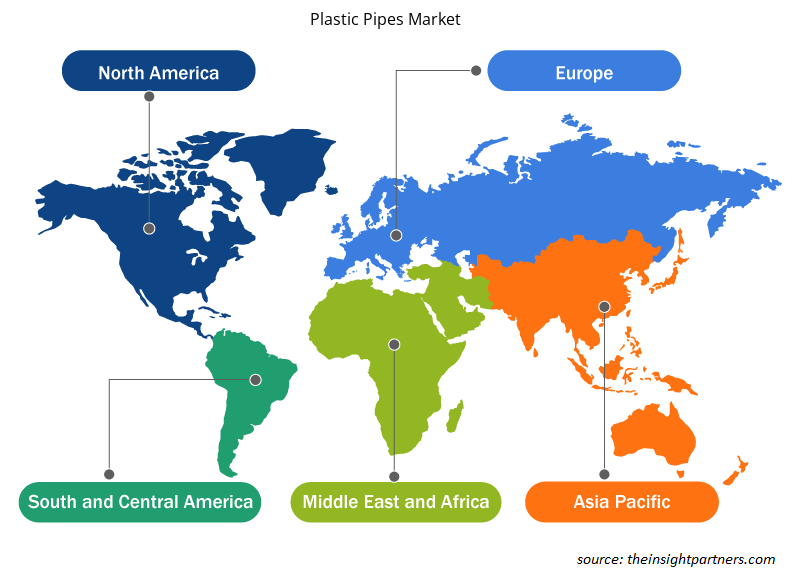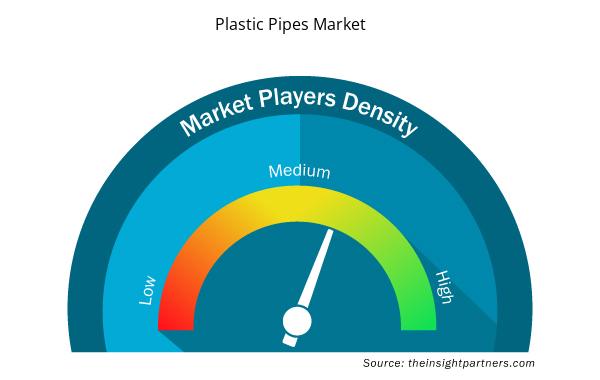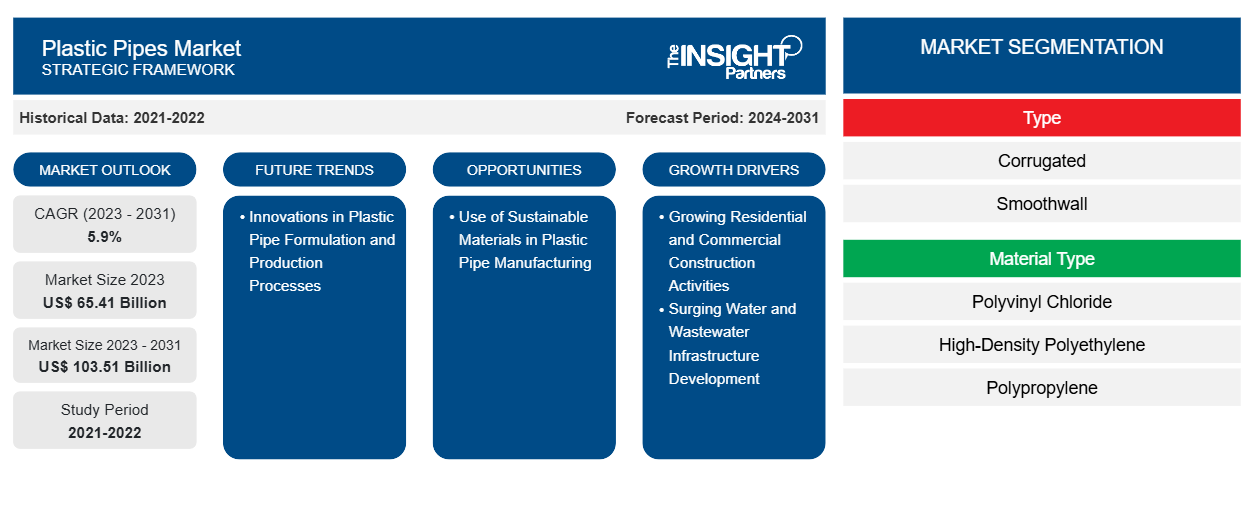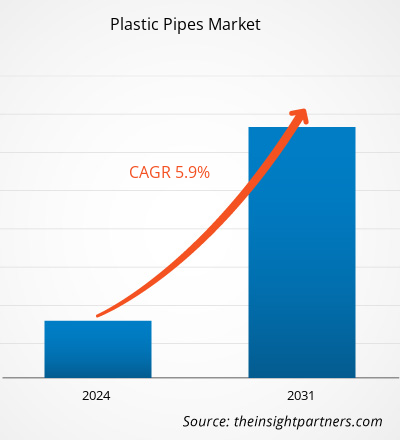塑料管道市场规模预计将从 2023 年的 654.1 亿美元增至 2031 年的 1035.1 亿美元;预计 2023-2031 年期间市场复合年增长率将达到 5.9%。塑料管道制造中使用可持续材料预计将成为市场的一个主要趋势。
塑料管道市场分析
不断增长的住宅和商业建筑活动正在推动塑料管道市场的增长。住房市场的增长归因于人口增长、城市化和有利的经济条件等因素。根据 Redfin 的数据,2024 年 1 月售出的房屋数量为 284,121 套;比 2023 年 1 月美国售出的数量高出 1.8%。住宅建筑是私营部门的重要组成部分。2023 年 6 月,经季节性调整后的年率显着增加至 8563 亿美元,比 5 月份修订后的估计值 8486 亿美元增长 0.9%。2023 年 3 月,政府启动了价值 29.6 亿美元的住房加速基金,以协助在加拿大各地建造至少 100,000 套房屋。在建筑中,塑料管用于供水、管道、暖通空调系统和灭火系统。塑料管用于住宅管道的热水和冷水管线。
塑料管道市场概况
全球塑料管道市场经历了显著增长,这得益于全球建筑业的蓬勃发展和水和废水管理计划的不断增加。市场增长归因于快速的工业化和城市化,尤其是在新兴经济体。此外,全球向可持续发展计划的转变也影响了塑料管道市场,制造商越来越注重采用环保配方。
定制此报告以满足您的需求
您可以免费定制任何报告,包括本报告的部分内容、国家级分析、Excel 数据包,以及为初创企业和大学提供优惠和折扣
- 获取此报告的关键市场趋势。这个免费样品将包括数据分析,从市场趋势到估计和预测。
塑料管道市场驱动因素和机遇
水和废水基础设施建设蓬勃发展
将资源回收和能源生产过程与清洁水生产相结合的城市污水处理厂对任何国家的可持续发展都做出了重大贡献。在过去二十年中,由于从能源生产过程中回收水的趋势,对污水处理的需求有所增加。联合国经济和社会事务部于 2022 年发布的一份报告强调了水和能源生产的相互依存关系日益增强,许多地区对这两种资源的需求都在增加。根据国际能源署目前的政策情景,到 2035 年,能源消耗预计将增加 50%,能源部门的用水量将增加 85%。
政府对废水管理的严格规定,例如在将工业废水排放到水体之前对其进行处理,促进了废水基础设施的发展。美国环境保护署 (EPA) 于 2022 年 12 月发布了《国家污染物排放消除系统备忘录》。该备忘录涉及授权各州和市政当局管理国家污染物排放消除系统和预处理计划。此扩展版本旨在改进旧版本的系统(于 2022 年 4 月推出),以纳入补充许可机制和建议,并加快减少 PFAS 排放到水体的努力。因此,水和废水基础设施开发的激增推动了塑料管道市场的增长。
塑料管道配方和生产工艺的创新
塑料管道市场正在见证塑料配方和生产工艺的多项创新。这些进步旨在提高塑料管道的性能、可持续性和成本效益。技术和材料科学的最新发展为塑料管道市场的纳米技术、智能传感器集成和增材制造铺平了道路。纳米技术在塑料管道制造中的整合涉及利用纳米复合材料来改善材料的机械性能。研究旨在探索将纳米材料加入 PVC 管道以改善其性能同时保留其固有特性的潜力。纳米技术的这种应用代表着一项进步,因为它解决了塑料管道的关键性能方面并使其应用多样化。
塑料管道市场报告细分分析
有助于得出塑料管道市场分析的关键部分是类型、材料类型、应用和最终用途行业。
- 根据类型,市场分为瓦楞纸和光面纸。瓦楞纸细分市场进一步分为单壁瓦楞纸和多壁瓦楞纸。光面纸细分市场在 2023 年占据了市场主导地位。
- 根据材料类型,市场分为聚氯乙烯、高密度聚乙烯、聚丙烯等。聚氯乙烯领域在 2023 年占据了市场主导地位。
- 根据应用,市场分为供水、污水和排水、灌溉、天然气分配等。供水部门在 2023 年占据了市场主导地位。
- 根据最终用途行业,市场分为建筑和基础设施、水和废水管理、石油和天然气等。建筑和基础设施部门在 2023 年占据了市场主导地位。
塑料管道市场份额按地区分析
塑料管道市场报告的地理范围主要分为五个区域:北美、亚太、欧洲、中东和非洲、南美和中美。
亚太地区在 2023 年占据最大市场份额,预计在预测期内将实现最高复合年增长率。欧洲在 2023 年占据第二大塑料管道市场份额。由于建筑业、废水处理设施以及石油和天然气行业的增长,亚太地区是塑料管道的主要市场。新兴经济体外国直接投资的增加也导致区域经济增长,进一步促进了该地区的工业化。亚太地区对石油和天然气的需求正在增加。根据国际能源署的数据,全球石油需求在 2021 年反弹,预计到 2025 年亚洲将占石油需求的 77%。预计到 2025 年,亚洲石油进口需求将超过每天 3100 万桶。所有主要亚洲经济体都严重依赖从中东和非洲进口的石油。该地区各国已启动项目以满足日益增长的石油和天然气需求。例如,2023 年 4 月,印度阿萨姆邦雅鲁藏布江下游连接乔尔哈特和马久利的亚洲最大海底碳氢化合物管道由 Indradhanush Gas Grid Limited (IGGL) 建成。此外,亚太地区基础设施项目投资的不断增长预计将在预测期内提振塑料管道市场。
塑料管道市场区域洞察
Insight Partners 的分析师已详尽解释了预测期内影响塑料管道市场的区域趋势和因素。本节还讨论了北美、欧洲、亚太地区、中东和非洲以及南美和中美洲的塑料管道市场细分和地理位置。

- 获取塑料管道市场的区域特定数据
塑料管道市场报告范围
| 报告属性 | 细节 |
|---|---|
| 2023 年的市场规模 | 654.1亿美元 |
| 2031 年市场规模 | 1035.1亿美元 |
| 全球复合年增长率(2023 - 2031) | 5.9% |
| 史料 | 2021-2022 |
| 预测期 | 2024-2031 |
| 涵盖的领域 | 按类型
|
| 覆盖地区和国家 | 北美
|
| 市场领导者和主要公司简介 |
|
塑料管道市场参与者密度:了解其对业务动态的影响
塑料管道市场正在快速增长,这得益于终端用户需求的不断增长,而这些需求又源于消费者偏好的不断变化、技术进步以及对产品优势的认识不断提高等因素。随着需求的增加,企业正在扩大其产品范围,进行创新以满足消费者的需求,并利用新兴趋势,从而进一步推动市场增长。
市场参与者密度是指在特定市场或行业内运营的企业或公司的分布情况。它表明在给定市场空间中,相对于其规模或总市场价值,有多少竞争对手(市场参与者)存在。
在塑料管道市场运营的主要公司有:
- JM Eagle公司
- 乔治费歇尔有限公司
- 积水化学工业株式会社
- 中国联塑集团控股有限公司
- Finolex 工业有限公司
- Genuit 集团
免责声明:上面列出的公司没有按照任何特定顺序排列。

- 了解塑料管道市场主要参与者概况
塑料管道市场新闻及最新发展
塑料管道市场通过收集一手资料和二手资料后的定性和定量数据进行评估,其中包括重要的公司出版物、协会数据和数据库。以下列出了塑料管道市场的一些发展情况:
- Advanced Drainage Systems (ADS) 宣布计划在佛罗里达州莱克威尔斯建立一个新的制造工厂。ADS 生产大量波纹塑料管。该项目预计将于 2024 年在占地 100 英亩的土地上破土动工。(塑料技术,公司网站/新闻/2023 年)
- Uponor 使用 ISCC PLUS 认证的质量平衡方法,生产出世界上第一条循环 Uponor PEX 管道,其原材料 100% 以化学方式回收,这些原材料来自公司自己的 PEX 管道生产废料。这一突破性解决方案由 Uponor、Wastewise、Neste 和 Borealis 合作实现,他们已成功以工业规模将 PEX 管道制造废料化学回收为塑料原料。(Uponor Corporation,公司网站/ 2023 年)
塑料管道市场报告覆盖范围和交付成果
“塑料管道市场规模和预测(2021-2031 年)”报告对以下领域进行了详细的市场分析:
- 塑料管道市场规模及范围内所有主要细分市场的预测
- 塑料管道市场趋势以及市场动态,如驱动因素、限制因素和关键机遇
- 详细的波特五力分析和 SWOT 分析
- 塑料管道市场分析涵盖主要市场趋势、国家框架、主要参与者、法规和最新的市场发展。
- 行业格局和竞争分析,涵盖市场集中度、热点图分析、知名企业以及塑料管道市场的最新发展
- 详细的公司简介
- 历史分析(2 年)、基准年、预测(7 年)及复合年增长率
- PEST 和 SWOT 分析
- 市场规模价值/数量 - 全球、区域、国家
- 行业和竞争格局
- Excel 数据集


- Microplate Reader Market
- Adaptive Traffic Control System Market
- Rugged Servers Market
- Europe Tortilla Market
- Integrated Platform Management System Market
- Dealer Management System Market
- Queue Management System Market
- Small Internal Combustion Engine Market
- Medical Enzyme Technology Market
- Railway Braking System Market

Report Coverage
Revenue forecast, Company Analysis, Industry landscape, Growth factors, and Trends

Segment Covered
This text is related
to segments covered.

Regional Scope
North America, Europe, Asia Pacific, Middle East & Africa, South & Central America

Country Scope
This text is related
to country scope.
常见问题
The market is expected to register a CAGR of 5.9% during 2023–2031.
Key players in the plastic pipes market include JM Eagle Inc, Uponor Corp, Georg Fischer Ltd, Sekisui Chemical Co Ltd, China Lesso Group Holdings Ltd, Astral Poly Technik Limited, Finolex Industries Ltd, Genuit Group Plc, Formosa Plastics Corp, Vasen Europe, Luna Plast, Orbia, Aliaxis Holdings SA, and Advanced Drainage Systems Inc.
Growing residential and commercial construction activities and surging water and wastewater infrastructure development are driving the market.
In 2023, Asia Pacific held the largest share of the global plastic pipes market. The rise in government initiatives for water and wastewater management across emerging economies of Asia Pacific drives market growth.
The polyvinyl chloride segment held the largest share of the global plastic pipes market in 2023. Polyvinyl chloride pipes offer several advantages, such as durability, cost-effectiveness, chemical resistance, and versatility.
The use of sustainable materials in plastic pipe manufacturing is expected to emerge as a future trend in the market.
Trends and growth analysis reports related to Chemicals and Materials : READ MORE..
The List of Companies - Plastic Pipes Market
- JM Eagle Inc
- Georg Fischer Ltd
- Sekisui Chemical Co Ltd
- China Lesso Group Holdings Ltd
- Finolex Industries Ltd
- Genuit Group Plc
- Vasen Europe
- Luna Plast
- Orbia
- Aliaxis Holdings SA
- Advanced Drainage Systems Inc.
- ASTRAL PIPES
- Wienerberger AG
- NAN YA PLASTICS CORPORATION
- Reboca
The Insight Partners performs research in 4 major stages: Data Collection & Secondary Research, Primary Research, Data Analysis and Data Triangulation & Final Review.
- Data Collection and Secondary Research:
As a market research and consulting firm operating from a decade, we have published and advised several client across the globe. First step for any study will start with an assessment of currently available data and insights from existing reports. Further, historical and current market information is collected from Investor Presentations, Annual Reports, SEC Filings, etc., and other information related to company’s performance and market positioning are gathered from Paid Databases (Factiva, Hoovers, and Reuters) and various other publications available in public domain.
Several associations trade associates, technical forums, institutes, societies and organization are accessed to gain technical as well as market related insights through their publications such as research papers, blogs and press releases related to the studies are referred to get cues about the market. Further, white papers, journals, magazines, and other news articles published in last 3 years are scrutinized and analyzed to understand the current market trends.
- Primary Research:
The primarily interview analysis comprise of data obtained from industry participants interview and answers to survey questions gathered by in-house primary team.
For primary research, interviews are conducted with industry experts/CEOs/Marketing Managers/VPs/Subject Matter Experts from both demand and supply side to get a 360-degree view of the market. The primary team conducts several interviews based on the complexity of the markets to understand the various market trends and dynamics which makes research more credible and precise.
A typical research interview fulfils the following functions:
- Provides first-hand information on the market size, market trends, growth trends, competitive landscape, and outlook
- Validates and strengthens in-house secondary research findings
- Develops the analysis team’s expertise and market understanding
Primary research involves email interactions and telephone interviews for each market, category, segment, and sub-segment across geographies. The participants who typically take part in such a process include, but are not limited to:
- Industry participants: VPs, business development managers, market intelligence managers and national sales managers
- Outside experts: Valuation experts, research analysts and key opinion leaders specializing in the electronics and semiconductor industry.
Below is the breakup of our primary respondents by company, designation, and region:

Once we receive the confirmation from primary research sources or primary respondents, we finalize the base year market estimation and forecast the data as per the macroeconomic and microeconomic factors assessed during data collection.
- Data Analysis:
Once data is validated through both secondary as well as primary respondents, we finalize the market estimations by hypothesis formulation and factor analysis at regional and country level.
- Macro-Economic Factor Analysis:
We analyse macroeconomic indicators such the gross domestic product (GDP), increase in the demand for goods and services across industries, technological advancement, regional economic growth, governmental policies, the influence of COVID-19, PEST analysis, and other aspects. This analysis aids in setting benchmarks for various nations/regions and approximating market splits. Additionally, the general trend of the aforementioned components aid in determining the market's development possibilities.
- Country Level Data:
Various factors that are especially aligned to the country are taken into account to determine the market size for a certain area and country, including the presence of vendors, such as headquarters and offices, the country's GDP, demand patterns, and industry growth. To comprehend the market dynamics for the nation, a number of growth variables, inhibitors, application areas, and current market trends are researched. The aforementioned elements aid in determining the country's overall market's growth potential.
- Company Profile:
The “Table of Contents” is formulated by listing and analyzing more than 25 - 30 companies operating in the market ecosystem across geographies. However, we profile only 10 companies as a standard practice in our syndicate reports. These 10 companies comprise leading, emerging, and regional players. Nonetheless, our analysis is not restricted to the 10 listed companies, we also analyze other companies present in the market to develop a holistic view and understand the prevailing trends. The “Company Profiles” section in the report covers key facts, business description, products & services, financial information, SWOT analysis, and key developments. The financial information presented is extracted from the annual reports and official documents of the publicly listed companies. Upon collecting the information for the sections of respective companies, we verify them via various primary sources and then compile the data in respective company profiles. The company level information helps us in deriving the base number as well as in forecasting the market size.
- Developing Base Number:
Aggregation of sales statistics (2020-2022) and macro-economic factor, and other secondary and primary research insights are utilized to arrive at base number and related market shares for 2022. The data gaps are identified in this step and relevant market data is analyzed, collected from paid primary interviews or databases. On finalizing the base year market size, forecasts are developed on the basis of macro-economic, industry and market growth factors and company level analysis.
- Data Triangulation and Final Review:
The market findings and base year market size calculations are validated from supply as well as demand side. Demand side validations are based on macro-economic factor analysis and benchmarks for respective regions and countries. In case of supply side validations, revenues of major companies are estimated (in case not available) based on industry benchmark, approximate number of employees, product portfolio, and primary interviews revenues are gathered. Further revenue from target product/service segment is assessed to avoid overshooting of market statistics. In case of heavy deviations between supply and demand side values, all thes steps are repeated to achieve synchronization.
We follow an iterative model, wherein we share our research findings with Subject Matter Experts (SME’s) and Key Opinion Leaders (KOLs) until consensus view of the market is not formulated – this model negates any drastic deviation in the opinions of experts. Only validated and universally acceptable research findings are quoted in our reports.
We have important check points that we use to validate our research findings – which we call – data triangulation, where we validate the information, we generate from secondary sources with primary interviews and then we re-validate with our internal data bases and Subject matter experts. This comprehensive model enables us to deliver high quality, reliable data in shortest possible time.


 获取此报告的免费样本
获取此报告的免费样本